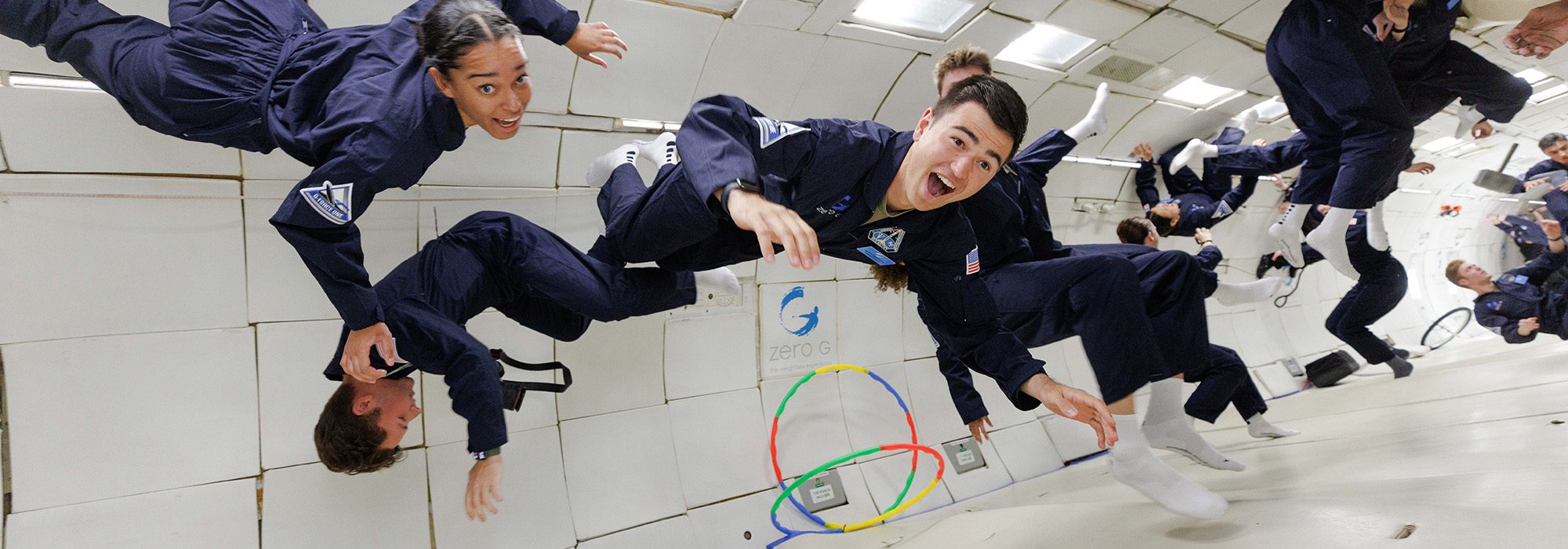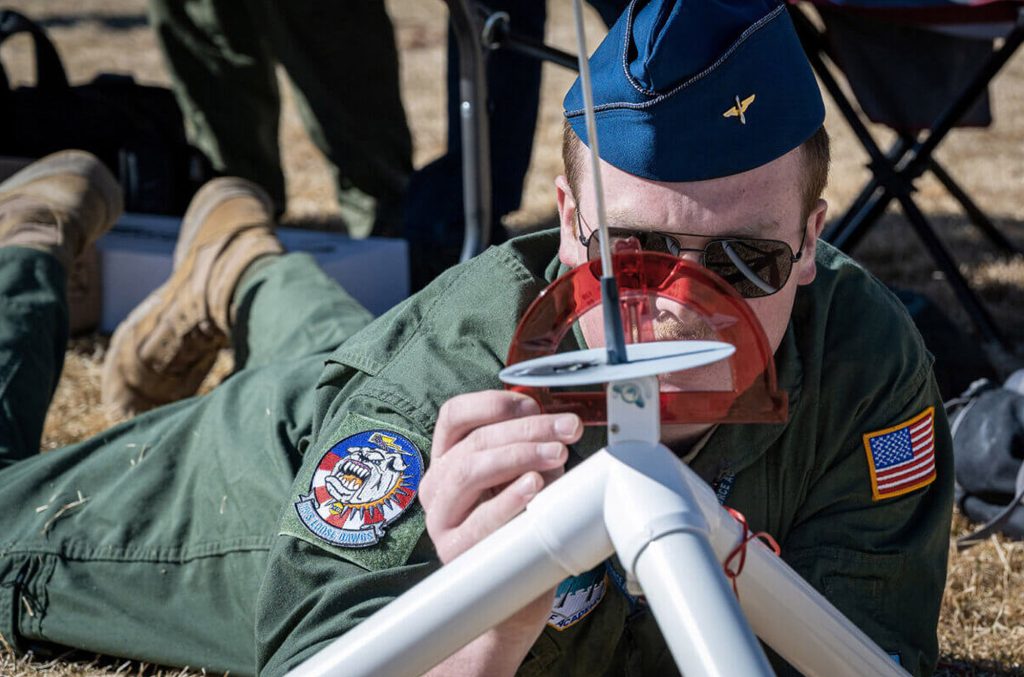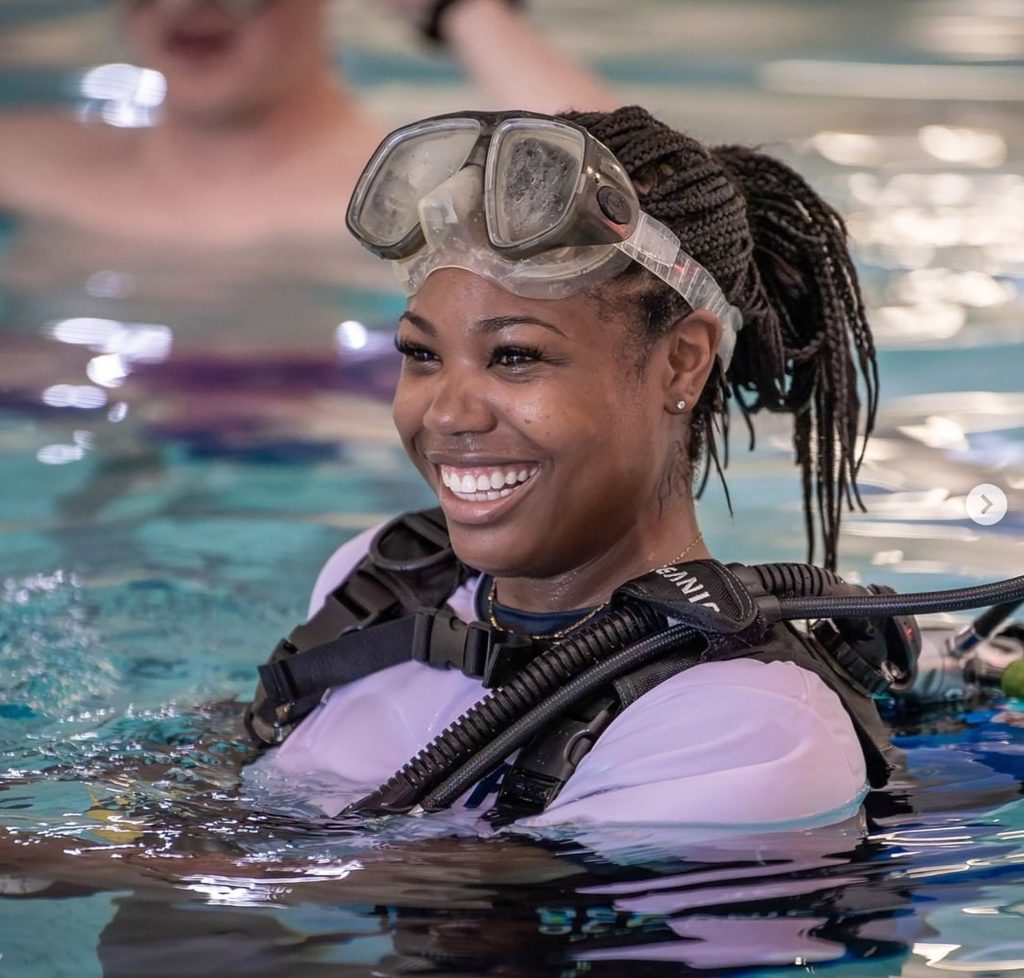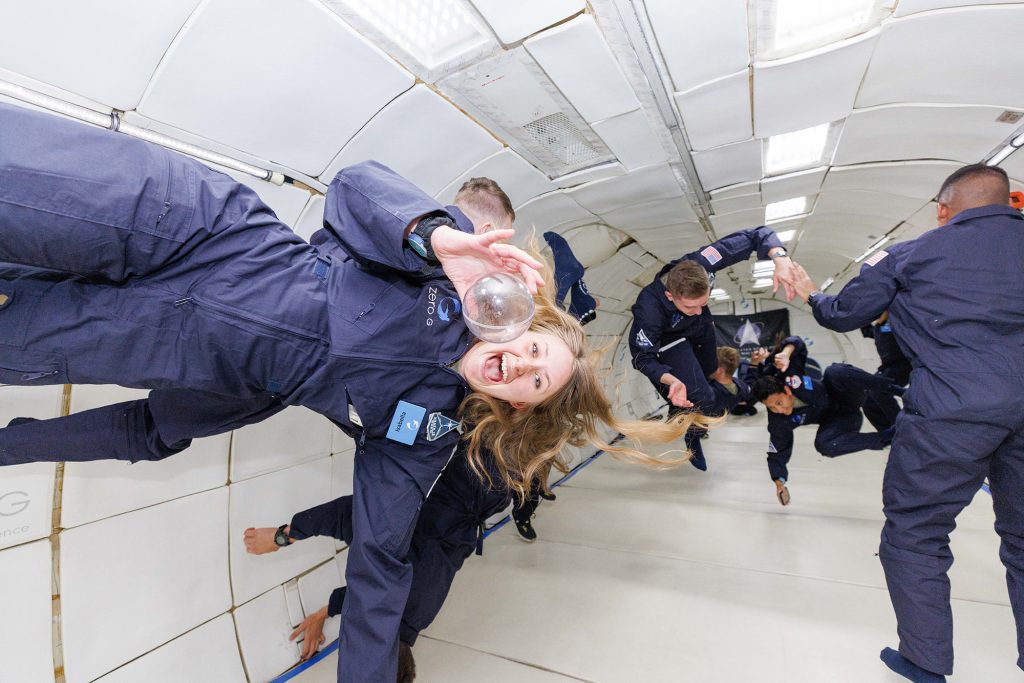How the Air Force Academy and the Space Force are inspiring future Guardians.
June 6, 2022, was a perfect Colorado Springs, Colo., day: sunny and 75, with cotton-ball clouds. Second-year U.S. Air Force Academy (USAFA) Cadet Carleton Liden knew from the moment he woke up that it would be one of the best days of his life.
The dark-haired 19-year-old from Folsom, Calif., ate a carefully planned breakfast of bananas and peanut butter—he’d been told those foods tasted the same coming back up as they did going down—and boarded a bus bound for the flight line at the Colorado Springs Airport. There, he and a cohort of two dozen other cadets donned crisp Navy-colored flight suits emblazoned with an American flag patch on one shoulder and “G-Force One” on the other. Following a familiarization brief, the cadets boarded a Boeing 727 specially modified with padded walls and best known by its vivid nickname: the Vomit Comet. They laid flat on their backs in the seatless cabin and waited as the plane rose to cruising altitude, then entered a steep vertical climb. Near 25,000 feet of altitude, by now under 3 Gs of pressure, the countdown started: “Five, four, three, two, … one.”
USAFA Cadet Carleton LidenBeing able to see the mission firsthand—all the different jobs—was very eye-opening for me, … I could then define it for myself.
Lift off. The cadets were suddenly floating free, as Earth relinquished its grip. They spun, soared, played with water droplets, and laughed giddily, totally weightless. True to its billing, a “good number” of the cadets lost their breakfast. Zero-G, the private company that operates the parabola flights, says two-thirds of passengers vomit during the experience; (Liden maintains he was among the lucky minority.)
But not even an encore appearance of breakfast dampened the mood aboard G-Force One.
“I don’t think I’ve ever seen somebody throwing up with a smile before,” Liden said. “All of the cadets were just radiating pure joy.”
In a series of 30-second parabolic maneuvers, which transition from hypergravity to weightlessness in an arc between 25,000 and 28,000 feet, the cadets experienced Martian and lunar microgravity as well as the zero-gravity conditions of space. They also experimented: maneuvering through hula hoops as they floated; setting a gyroscope centrifuge consisting of a bicycle tire mounted on a stick into infinite motion, imitating the giant gyroscopes that stabilize the International Space Station.
For Liden, the greatest marvel was the sensation of movement itself.
“They say that you can’t ‘swim’ [in zero gravity] because there’s no resistance in the air,” he said. “But you don’t really realize what that means until you’re just flailing around in place trying to figure out how to get somewhere.”
The parabola flight the cadets experienced is about as close as you can get to space without getting on a launch manifest. NASA astronaut and Marine Lt. Col. Jasmin Moghbeli said at a July news conference, prior to commanding the SpaceX Crew-7 flight to the International Space Station, that her parabola flight had been her only experience of weightlessness prior to her six-month space mission. Zero-G’s website sports testimonials from Martha Stewart, the late physicist Steven Hawking, and other celebrities who have shelled out nearly $10,000 for a taste of astronaut life. But the sponsor of this particular field trip was the U.S. Space Force, the still-new military service made up predominantly of operations, engineering, acquisition, and intelligence specialists.
The flight is the crown jewel of the Air Force Academy’s new Azimuth program for cadets interested in joining the service. And it appears to be off to a brilliantly successful start: Interest has soared fourfold since the program debuted in summer 2022, when only a little more than 100 cadets expressed interest in competing for the academy’s 96 Space Force slots, according to Lt. Col. Adam Wasinger, a leader of the academy’s Space Force detachment.
Azimuth’s emphasis on space exploration and activities has generated interest well in excess of its participants. Though the earthbound Space Force has at times come under criticism for appealing too strongly to astronaut imagery and aspirations, Azimuth may help the service achieve critical objectives, including creating a unique and attractive culture.
Making It Meaningful
Azimuth parallels several long-standing Air Force Academy summer programs designed to give cadets a taste of possible future military careers. These include the Soaring Program, which gives many cadets their first taste of hands-on flight in twin-seat TG-16A gliders; the Jump Program, the most popular of these, which culminates in solo free-fall parachute jumps after a week of training; and the Special Warfare Orientation Course, which exposes participants to the rigors of combat rescuemen and joint tactical air controllers. Cadets can pick just one, and space is shared with participants from the other service academies and ROTC.
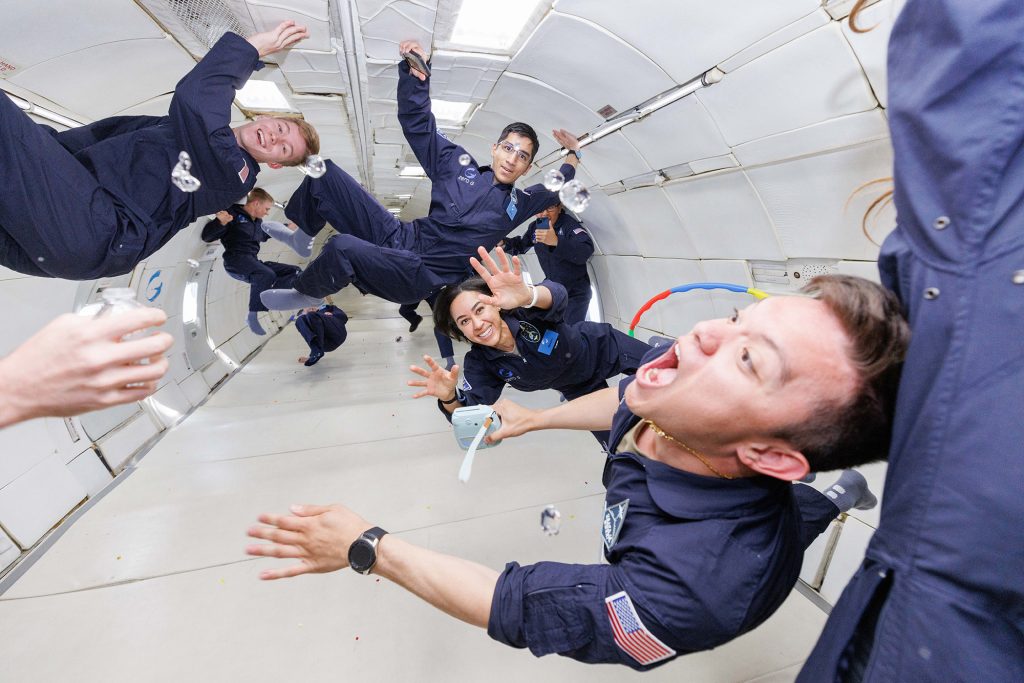
“To participate in Azimuth, they had to give up either Jump or Soar, so we wanted to make it meaningful enough for them,” said Space Force 2nd Lt. Zach Szvetecz, who helped design Azimuth’s inaugural program as an academy upperclassman.
Szvetecz, who also helped create the academy’s i5 national space outreach organization to help inspire youth to pursue future Space Force careers, was given charge of the student-led Azimuth effort. Along with several other rising first-degree cadets, they zoomed in on the disconnect between Space Force and every other military service. U.S. Naval Academy Midshipmen can board surface ships and subs, getting a feel for the equipment they’ll someday be operating and maintaining. U.S. Military Academy cadets at West Point get to experience live-fire training and ground maneuver. But Guardians, on the other hand, may never touch the satellites they direct and monitor.
“We wanted a way for people interested in Space Force to [have those experiences], because it is so different,” said Space Force 2nd Lt. Jennifer Vandenberg, another Azimuth contributor. The zero-gravity flight was an opportunity for cadets to “get a feel” for space and the forces acting on the satellites they might one day manage, she said.
“We were able to do experiments [on the flight] that we can’t test on the ground,” she noted. “So that really, I think, put us together in a place where we knew that what we were doing was going to have an impact on other people.”
Designing Azimuth
As Space Force-bound upperclassmen, the designers were also keenly aware that helping their future service component better define its separate identity can benefit all Guardians. Azimuth joins the satellite-focused Cadet Space Operations Squadron and a rocket-building club called Blue Horizon as space-centric programs at the USAFA. But Azimuth was always intended to be more comprehensive and holistic than the other efforts, incorporating nearly every aspect of space operations in its program.
“We wanted to make sure we went about the planning process in a way that would create that Space Force culture that we wanted—within the Air Force itself,” said Szvetecz.
The resulting two-week program includes tours of Buckley, Schriever, and Peterson Space Force bases, as well as Cheyenne Mountain Space Force Station, all of which are conveniently clustered near the academy in Colorado Springs. Cadets are also exposed to the space-focused work of local defense contractors, including Lockheed Martin Corp. and Sierra Space. The 58 Azimuth cadets, selected from an applicant pool more than three times that size, also learned satellite operations and completed a two-day capstone project on rocket design and launch, concluding with a competition to demonstrate what they’d learned about the physics of space and rocketry.
For Liden, who knew he wanted a career in space operations even before attending Azimuth, the combination of hands-on exposure and classroom instruction proved clarifying. He came out of Azimuth more intrigued with intelligence as a career specialty, having learned about intel collection and processing, and also more certain than before that cyber operations and flight ops were not for him. Prior to Azimuth, he said, the Space Force had seemed opaque; afterward, it was no longer a mystery.
“Because the Space Force is so new, especially at the Air Force Academy, there is almost no educational information on it available to the public, where you can find out what each job does,” he said. “Being able to see the mission firsthand—all the different jobs—was definitely very eye-opening for me, because I could then define it for myself.”
Now a second-year cadet, Liden returned to Azimuth as part of its cadre of student instructors.
The 2023 Azimuth program expanded into three separate three-week sessions over the summer, with 195 students participating, including cadets from the other service academies and ROTC. New experiences were added, including an electronic warfare simulator. Using a new piece of Space Force technology, the winkingly named Electronic Warfare Operating Kit, or EWOK, cadets were able to manipulate variables such as power and signal feeds and react to network degradations, learning about how EW can impact space operations.
Third-year cadet Jacqueline Kelly, a member of this year’s student cadre, said the message drove home the essential but often invisible nature of Space Force work. “If we do our job, and everything goes how it’s supposed to go … everybody will just go on and nobody will understand what Space Force did,” she said. “But if we fail our job and Space Force doesn’t manage to protect the domain that it’s protecting, all our GPS abilities will be crippled. Nobody will be able to drop precision-guided bombs. … That was pretty memorable.”
Cadets who completed Azimuth this year did not experience the Zero-G flights, due to equipment issues. Instead, Azimuth planners pivoted to Scuba training, allowing cadets to experience neutral buoyancy the way astronauts do at NASA’s massive underwater lab in Houston. A dozen feet below the surface, freshly Scuba-certified cadets assembled PVC pipes into a stable structure they could swim through and learned to inflate underwater air-lift bags, manipulating the buoyancy to lift or lower items.
“It mirrored being in a zero-gravity environment to the best of our ability,” Kelly said. “Plus, because we were mirroring astronaut training, that just sounds pretty cool.”
Whether Space Force introductory activities should reflect astronaut training remains controversial. From its earliest days, critics have looked askance at anything that sought to capitalize on human spaceflight, which, for now at least, is beyond the scope of Space Force operations. USSF’s first 30-second recruiting ad opened with a young woman gazing at the stars and later shows her in what appears to be an astronaut helmet. The reality is far different. Roughly half the Space Force workforce is involved in acquisition; many will never touch a satellite control panel, let alone experience weightlessness.
Finding The Right Guardians
Unlike the other military services, the relatively tiny Space Force, with fewer than 7,000 personnel billets, has more applicants than available jobs. At less than 4 years old and with even newer entry-level pipelines, having staffed up initially with lateral transfers from the Air Force and other services, the Space Force seeks applicants who understand what it does and who are interested in its core missions. Messaging is critical, said Lawrence Hanser, a senior behavioral scientist at the Rand Corporation. In a study published in June, “Designing a New Framework for the U.S. Space Force Workforce,” Hanser and his co-authors called for the Space Force to cultivate a distinct service culture and the personnel framework to sustain it.
Chief of Space Operations Gen. B. Chance Saltzman has said repeatedly that the culture will evolve naturally and cannot be unilaterally imposed from the top down or declared by any individual. But individual leaders can affect culture through their own behavior, directives, training, and mission focus.
To attract and retain Space Force officers, USSF must “be really careful with not making it appear to be something that it’s not,” Hanser said.
Nonetheless, Hanser said Azimuth does address a need identified in his study: a pre-commissioning, culture-building event that can allow future Guardians to start developing a collective sense of identity. His conviction was deepened when he heard a Space Force general describe how intelligence specialists and satellite operators sat side-by-side on operating floors, close enough to develop an understanding of each other’s jobs.
“There are aspects unique to operating in the space domain, the knowledge of which may strengthen all USSF officers in their service,” the Rand report states. “To impart and reinforce that knowledge and the ethos associated with it to every USSF officer regardless of technical specialty and projected career path would unify Space Force members and socialize them to the same, shared USSF culture.”
Azimuth’s third chapter is already in development. Liden said planners hope to involve Star Harbor, a private venture developing a commercially available astronaut training program that anticipates a not-so-distant future in which NASA no longer has an effective monopoly on astronaut production and throughput. USAFA’s program, at least for now, will maintain the wonder of space as a critical cultural touchstone for future Guardians.
And, at least for a few Space Force hopefuls, the service represents a stepping-stone for bigger space dreams. Liden is one. His space fascination as a child blossomed into astronaut dreams, and ultimately informed his choice to study at the academy.
“While I don’t necessarily see myself becoming an astronaut through the Space Force, I see it as pretty much the best path that I could put myself on to get to that goal,” he said. “And I think a lot of people are in a similar situation, where they’re using Space Force as a way to grow and work their way into the space environment as a whole, to hopefully build connections that will help them into the astronaut program.”
